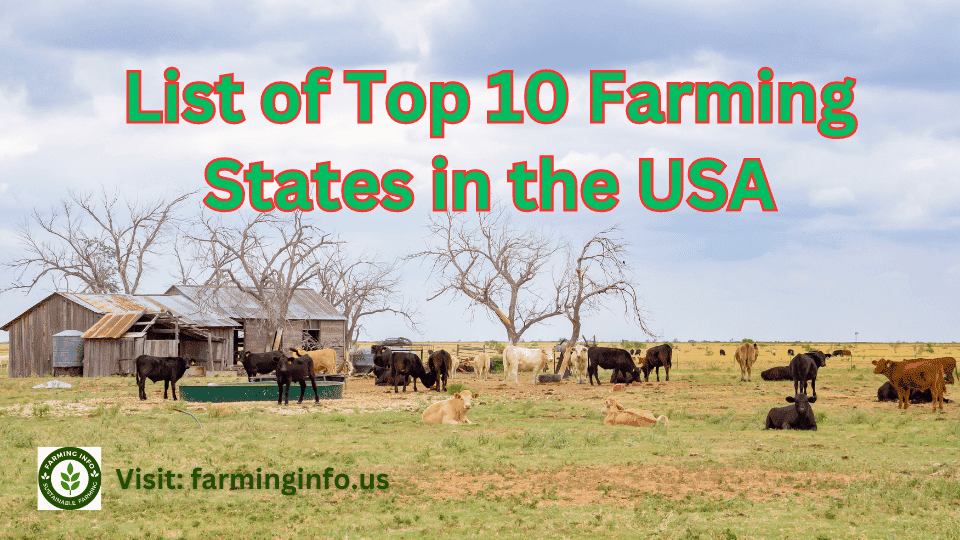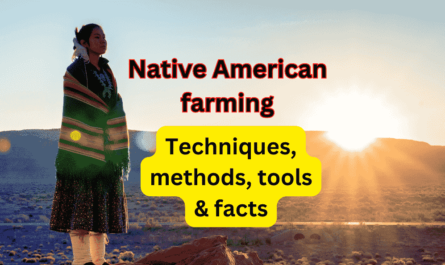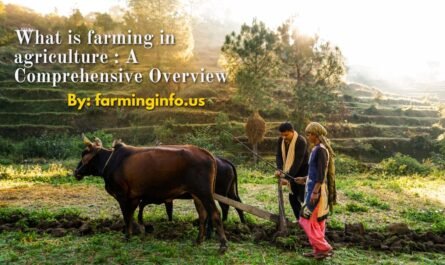The United States boasts a diverse agricultural landscape, with some states excelling in specific sectors while others offer a broader range of farming opportunities. This article highlights the top 10 states renowned for their agricultural prowess, considering factors such as crop production, livestock, climate, and overall farming conditions.

List of Top 10 Best Farming States in the USA
A fun and engaging look at the most popular agricultural states in the U.S. Explore the cultural significance of farming in these regions, their contribution to the nation’s food supply, and the unique charm of rural life.
Factors Contributing to Farming Success
Before diving into the state-by-state analysis, it’s essential to understand the key elements that contribute to a state’s agricultural success:
- Climate and Geography: Favorable weather conditions and diverse terrains can support a wide range of crops and livestock.
- Soil Quality: Fertile soil is crucial for high yields and crop health.
- Water Availability: Adequate water resources are essential for irrigation and livestock.
- Agricultural Infrastructure: A well-developed infrastructure, including transportation, storage, and processing facilities, is vital.
- Government Support: Policies, subsidies, and research initiatives can significantly impact farming success.
- Technology Adoption: The integration of modern technology enhances efficiency and productivity.
- Market Access: Proximity to markets and access to transportation routes facilitate the distribution of agricultural products.
With these factors in mind, let’s explore the top 10 best farming states in the USA:
1. California:
The Golden State of Agriculture
Agricultural Powerhouse: California is undoubtedly the leading agricultural state in the US, contributing significantly to the nation’s food supply.
Diverse Crops: The state boasts a vast array of crops, including fruits, vegetables, nuts, and specialty crops like almonds and avocados.
Challenges: Water scarcity and wildfires pose significant threats to agriculture.
California reigns as the undisputed king of U.S. agriculture. Boasting a Mediterranean climate and fertile valleys, it produces a staggering variety of crops, from fruits and nuts to vegetables and dairy. Its agricultural revenue surpasses that of any other state, making it a cornerstone of the nation’s food supply.
2. Iowa:
The Corn and Soybean Capital
- Heartland of America: Iowa is synonymous with corn and soybean production, earning the title of the “breadbasket of the nation.”
- Livestock: The state is also a major producer of hogs and cattle.
- Strengths: Fertile soil, favorable climate, and advanced farming practices contribute to its agricultural success.
Iowa is synonymous with American agriculture. Its vast, fertile plains make it the nation’s leading producer of corn and soybeans. With a strong emphasis on efficiency and technology, Iowa farmers drive the country’s food production and biofuel industries.
3. Texas:
The Lone Star State of Agriculture
Diverse Landscape: Texas offers a variety of agricultural environments, ranging from cotton and wheat in the plains to citrus and cattle in the southern regions.
Livestock Dominance: The state is a major producer of beef cattle, cotton, and grains.
Challenges: Drought and extreme weather events can impact crop yields.
Texas boasts a vast and diverse agricultural landscape. As the nation’s top producer of cattle, cotton, and sheep, it’s a powerhouse in livestock and fiber production. With a mix of arid plains and fertile river valleys, Texas supports a wide range of crops, including cotton, wheat, sorghum, and citrus.
4. Nebraska:
The Cornhusker State
- Grain Powerhouse: Nebraska is a leading producer of corn, soybeans, wheat, and beef cattle.
- Irrigated Agriculture: The state relies heavily on irrigation for crop production.
- Challenges: Drought is a recurring issue, impacting crop yields and livestock.
Nebraska is a heartland agricultural powerhouse. Known as the “Cornhusker State,” it’s a leading producer of corn and soybeans. Beyond these staples, Nebraska also excels in beef cattle production and wheat cultivation. Its vast, flat plains offer ideal conditions for large-scale farming operations.
5. Illinois:
The Prairie State’s Bounty
- Corn and Soybean Giant: Illinois is a major producer of corn and soybeans, contributing significantly to the nation’s agricultural output.
- Industrial Agriculture: The state has a strong agricultural processing industry.
- Challenges: Soil erosion and water quality issues are concerns.
Illinois is a major agricultural player, known for its rich, fertile soil. Corn and soybeans are the state’s primary crops, with Illinois ranking among the top producers nationally. The state also has a significant livestock industry, particularly in hogs, making it a key player in the nation’s meat production.
6. Minnesota:
The North Star State’s Agricultural Might
- Dairyland: Minnesota is renowned for its dairy industry, producing a significant portion of the nation’s milk and cheese.
- Diverse Crops: The state also grows a variety of crops, including corn, soybeans, and wheat.
- Challenges: Cold winters can impact livestock and crop production.
Minnesota is a significant agricultural powerhouse, known for its diverse production. It’s the nation’s top producer of turkeys and sugar beets, while also ranking high in hogs, corn, and soybeans. The state’s cool climate and rich soils contribute to its success in dairy and other specialty crops, making it a vital player in the U.S. food industry.
7. Kansas:
The Wheat State
- Wheat State: Kansas is a leading producer of wheat, earning the nickname “the Wheat State.”
- Beef Cattle: The state also has a significant beef cattle industry.
- Challenges: Drought and extreme weather events can impact crop yields.
Kansas is renowned as the “Wheat State” due to its vast wheat production, leading the nation in winter wheat cultivation. Beyond wheat, it’s also a significant producer of corn, sorghum, and beef cattle. The state’s flat, fertile plains and consistent climate make it an ideal environment for large-scale grain farming and livestock ranching.
8. Indiana:
The Hoosier State’s Agricultural Bounty
- Corn and Soybean Belt: Indiana is a key player in the corn and soybean production.
- Livestock: The state also has a significant hog and cattle industry.
- Challenges: Soil erosion and water quality are concerns.
Indiana is a significant contributor to U.S. agriculture. Known for its fertile soil and diverse climate, the state excels in producing corn and soybeans, ranking among the top producers nationally. Indiana also boasts a thriving livestock industry, with a strong focus on hogs and poultry. Additionally, the state is a leader in specialty crops like mint and pumpkins.
9. North Carolina:
The Tar Heel State’s Agricultural Diversity
- Diverse Agriculture: North Carolina offers a mix of crops and livestock, including tobacco, cotton, poultry, and swine.
- Challenges: Hurricanes and tropical storms can cause significant damage to crops.
North Carolina boasts a vibrant agricultural sector with a focus on diversity. It’s a leading producer of tobacco, sweet potatoes, turkeys, and hogs. The state’s climate allows for a wide range of crops, including cucumbers, peanuts, upland cotton, and bell peppers. With a mix of coastal plains, Piedmont, and mountainous regions, North Carolina offers a varied agricultural landscape.
10. Wisconsin:
- Dairyland: Similar to Minnesota, Wisconsin is known for its dairy industry and cheese production.
- Diverse Crops: The state also produces corn, soybeans, and other crops.
- Challenges: Cold winters can impact livestock and crop production.
Wisconsin is synonymous with dairy, earning its nickname as “America’s Dairyland.” The state leads the nation in cheese production, and is a major producer of milk and butter. Beyond dairy, Wisconsin is also a significant grower of cranberries, ginseng, and potatoes. Its diverse agricultural landscape, with a mix of prairies, forests, and lakes, supports a variety of crops and livestock.
Note: This list is based on various factors, including crop production, livestock, and overall agricultural economic impact. The rankings can vary depending on the specific criteria used.
Native American farming techniques, methods, tools, facts
Conclusion
The United States is a global leader in agriculture, with a diverse range of states contributing to its immense agricultural output. From the sun-kissed fields of California to the vast plains of the Midwest, each state offers unique agricultural strengths and challenges.
Whether you’re an aspiring farmer, a food enthusiast, or simply curious about where your food comes from, understanding the top farming states provides valuable insights into the complexity and importance of American agriculture.
Which state do you find most fascinating? Are you drawn to the diversity of California, the heartland charm of Iowa, or the unique offerings of other states? Share your thoughts in the comments below!


